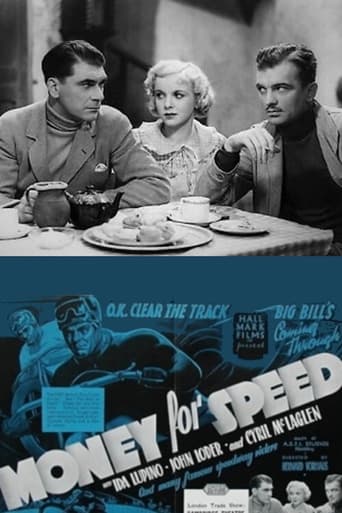Igenlode Wordsmith
"Money for Speed" is a cheaply-made film that no-one at the time saw any particular significance in: it attained the retrospective status of a curiosity thanks to the subsequent fame of its young editor, David Lean, and in 1992 appeared in the British Film Institute's "Missing Believed Lost" list. Although no domestic prints appear to have survived, a French-dubbed print and one with German subtitles ("Der Totenring"(?)) were eventually located, making it possible to screen this film once more. It showed this year as part of a David Lean festival, and proved lively, intriguing and very enjoyable -- in fact, little short of very enjoyable indeed.The picture is set in the world of motorcycle speedway racing, where cocky Australian newcomer Bill muscles in on the territory of the reigning champion, Mitch. With the Aussie flashing his winnings and soaking up the girls' attention, Mitch plans to take him down a peg. In pursuit of this aim, he introduces Bill to a bucolic vision of the mother-country -- innocent village lass Jane, in her quaint picture-postcard cottage presided over by her sweet elderly mother (Marie Ault, character actress stalwart of silent-screen hits such as "The Lodger" and "The Rat").Bill falls hook, line and sinker for the ruse... and so does the viewer, but not for long. For Jane -- a brilliant piece of acting by a very young Ida Lupino (allegedly only fifteen, although I rather suspect subsequent birth-date fiddling) -- is as hard-boiled as they come, and she and her mother can't wait to get out of their picturesque poverty, preferably at the expense of the mugs who come to admire it. (One of the best throw-away lines in the picture comes when an off-screen blast is casually dismissed as Ma busy putting 'woodworm-holes' into the furniture with her shotgun!) Bill, whose intentions don't extend beyond a quick tumble in the bushes, finds himself outflanked all along the line, and soon Jane is raking in every penny he's got in order to share it with her lover, Mitch -- while Mitch savours the impending locker-room humiliation of his rival when all is revealed on the brink of the big race. When the girl unexpectedly finds herself getting cold feet about the scheme, things have already gone a little too far...In many ways this film equals those twice its length and over ten times its budget. The (real-life) speedway footage, filmed at the director's own expense, is nail-biting even today. The plot is fast-moving, cynical, full of unexpected turns just when you think you know the score and never slipping into sentiment despite the story-line: it includes an implicit rape and a man burnt alive, and actions have consequences. The macho grudge match between the two riders, which in most films of this genre would be the triumphant climax of the plot, here gets Bill warned off the speedway circuit for unprofessional conduct rather than vindicating him at his opponent's expense.If it were not for one thing I should be tempted to rate "Money for Speed" very highly indeed. My problem is that at several crucial moments I was left simply confused as to what had just happened: does Mitch die, or not? Does Bill die, or not? (And am I imagining things, or is 'Jane' not the girl's real name anyway?) I'm not sure if the fault was in censorship or splices in the print, in the conventions of the era or in my understanding, but it left me taken aback and bemused at vital points, bringing me crashing back out of the story.Ida Lupino is outstanding in her dual role of wide-eyed innocent and hard-as-nails charmer, while Cyril McLaglen convincingly develops Bill from swaggering cock-of-the-walk to a devastated drunk while gradually converting audience sympathies along the way. John Loder does a good job as the disgruntled Mitch while Moore Marriott plays sidekick 'Shorty' in a straight performance that has nothing to do with his geriatric stunts for Will Hay. Despite its ultra-short running time (under an hour) the film manages a three-act plot structure and an innovative -- for the period -- opening credit sequence: it never feels either rushed or brief and repeatedly sidesteps audience expectations in what starts off as equable comedy and becomes progressively tenser and bleaker as it unfolds. This is a picture well worth seeing in its own right, disregarding any historical significance: a minor success on its release, it deserves to be better-remembered today.
allenrogerj
Like many quota quickies- or the ones that have survived- Money For Speed has some surprising virtues as well as the defects of quickly-written, quickly-filmed stories. The most common defect is the attempt to cram the plot of a full-length film into an hour-long film and Money for Speed shows it; as a result, all of the characters are stereotyped without explanation for who they are or their motives- Mitch, the villain, is simply a villain from stage melodrama from the start, Bill the hero is a crude simple Aussie all the way through, Ida Lupino does her best with what would become her characteristic role- the tart with a heart- but doesn't have room or time to be convincing in her transformation. Indeed, one of the interesting aspects of this film- superbly shot footage of real speedway races and- given the time it was made and the economy required- surprisingly convincing and effective special effects- makes the plot yet more absurd and unmoving. All the same it's well worth seeing: if most of the dialogue clunks, the scenes in the commentator's box are convincing, even if they have to explain what's happening to the audience; the action scenes are well done; Lupino does her best with an underwritten part with some bad dialogue and the scene in the changing-room before the big race looks like a real brawl and carries a convincing atmosphere of hatred and the races are very well-filmed and exciting.


